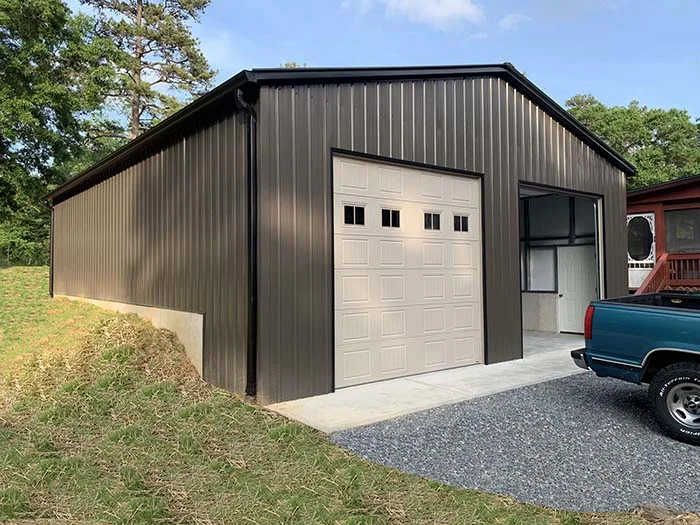Storage buildings have traditionally been seen as purely functional structures. Whether used to house personal belongings, business inventory, or industrial goods, their design has historically been simple and unremarkable.
However, as urbanization accelerates and the demand for space increases, storage buildings have begun to evolve into architectural marvels that defy expectations. These structures, once relegated to the back corners of cityscapes, are now taking center stage, blending form with function in unexpected and exciting ways. Today, storage buildings are pushing the boundaries of design, offering not only practical solutions but also aesthetic appeal that complements and enhances urban landscapes.
What Makes Modern Storage Buildings Stand Out As Architectural Marvels?
The evolution of storage buildings into architectural marvels is a direct response to the growing need for efficient use of urban space, as well as a desire for these structures to be more than just utilitarian. Today, storage buildings are not just places to store items—they are visually captivating landmarks that contribute to the character of a neighborhood or city.
Aesthetic Innovation
Modern storage buildings are increasingly being designed with a focus on aesthetics, rather than just practicality. Architectural firms are embracing bold, innovative designs that make these buildings stand out. The use of unique materials, dynamic shapes, and sustainable features is transforming the way storage buildings are perceived.
- Sleek, minimalist designs: Gone are the days of boxy, unattractive storage units. Architects are designing buildings with clean lines, contemporary shapes, and a focus on form. This minimalism can blend seamlessly into urban environments, making the buildings look sophisticated while serving their practical purposes.
- Use of unconventional materials: Modern storage buildings are incorporating materials that were once reserved for residential or commercial properties. Steel, glass, and timber are now being used to create visually striking facades. Some buildings feature facades made entirely of glass, allowing natural light to pour into the space while giving the building a transparent, airy feel.
- Sustainability and green architecture: Sustainability is a major consideration in modern architecture, and storage buildings are no exception. Many of today’s storage buildings are designed with eco-friendly features such as green roofs, solar panels, and rainwater harvesting systems. These sustainable elements not only reduce the building’s environmental impact but also contribute to the overall appeal of the structure.
Integration with Surrounding Architecture
Another standout feature of modern storage buildings is how they are designed to complement the surrounding architecture. In many cases, these buildings are not isolated from their environment but are integrated into the urban fabric. They may adopt elements from nearby structures or even serve as a transition between different architectural styles.
- Adaptive reuse of existing structures: Some architects are reimagining and repurposing older buildings into modern storage spaces. This adaptive reuse adds historical value and unique character to the design, giving a sense of continuity between the past and the present.
- Blending with public spaces: In urban areas, some storage buildings are strategically placed to serve as hubs that connect to public spaces. These buildings often incorporate elements such as walkways, plazas, and green spaces, transforming them into more than just storage spaces but integral parts of the community.
How Do Innovative Designs Transform the Purpose of Storage Buildings?
The transformation of storage buildings from functional structures to architectural masterpieces has also led to a shift in how they are used. Innovative design has fundamentally altered the role of storage buildings in urban environments, making them more versatile and contributing to the revitalization of entire neighborhoods.
Multi-Functional Spaces
Modern storage buildings are no longer just for storing physical items. Designers are now integrating a wide range of functions into these spaces, which allows them to serve as hubs for various activities. This shift is not only expanding the purpose of storage buildings but also helping to optimize limited urban space.
- Flexible storage options: Many new storage buildings feature modular, customizable storage solutions that allow individuals and businesses to adjust the space according to their needs. These modular designs can include everything from small personal storage units to larger spaces for industrial equipment.
- Co-working spaces and community hubs: In certain urban developments, storage buildings are being designed to include co-working areas, meeting rooms, or event spaces. This allows residents or businesses to use these spaces for more than just storage but also for creative or professional activities, making them more central to the neighborhood’s culture.
- Mixed-use developments: Some modern storage buildings are part of larger mixed-use developments that incorporate residential, commercial, and retail spaces. This integration helps to create vibrant communities where people can live, work, and store their belongings in one place. For example, a storage building may include a café or fitness center on the ground floor, making it a central point of interest in a city block.
Technological Advancements
Innovative designs are also integrating advanced technology into storage buildings. From smart storage solutions to automation and security features, technology is transforming the way these buildings function.
- Smart storage systems: The integration of technology into storage spaces has given rise to automated storage and retrieval systems. These systems, often used in commercial storage buildings, can automatically track inventory and retrieve stored items, significantly improving efficiency and reducing labor costs.
- Enhanced security features: Modern storage buildings are designed with security in mind. Many are equipped with surveillance cameras, motion detectors, and biometric access controls to ensure that stored items remain safe. Some buildings even offer 24/7 monitoring and remote access for customers.
- Energy-efficient systems: Innovations in energy-efficient technology, such as LED lighting, climate control, and solar panels, are helping modern storage buildings reduce their environmental impact. These technologies are not only cost-effective but also contribute to the overall sustainability of the building.
Why are Storage Buildings Becoming Iconic in Urban Architecture?
As cities continue to grow and evolve, the role of storage buildings in urban environments is becoming increasingly important. More than just a place to store belongings, these buildings are now seen as icons of urban design and a reflection of how cities are adapting to the demands of modern life.
Meeting the Demands of Urbanization
Urban areas are constantly expanding, and as populations increase, the need for storage solutions becomes even more pressing. Storage buildings are playing a key role in addressing this need by providing much-needed space in highly dense areas. This demand has made them not only practical but also symbolic of the urbanization process itself.
- Urban revitalization: In many cities, storage buildings have become part of larger urban renewal projects. By repurposing vacant lots or underused spaces, these buildings contribute to the revitalization of neighborhoods, providing new opportunities for development and commerce. Their striking designs often become focal points in the areas they occupy.
- Symbolizing efficiency: The modern storage building has come to represent efficiency in a time when space is increasingly scarce. Their clean, functional designs communicate the idea that we must make the most of limited resources, a message that resonates in urban areas where real estate is at a premium.
Becoming Landmarks
Some storage buildings are becoming true architectural landmarks, thanks to their innovative designs. These buildings, with their bold forms and cutting-edge technologies, are contributing to the distinctive character of the cities in which they are located.
- Iconic shapes and forms: Many modern storage buildings are characterized by unique, eye-catching shapes. For example, some feature twisting, asymmetrical forms, while others incorporate unusual angles or modular components that make them stand out from traditional building designs.
- Sustainability as a key feature: Sustainable design features, such as green roofs, solar panels, and water conservation systems, are also helping storage buildings gain recognition. These environmentally conscious features not only benefit the planet but also position these buildings as forward-thinking icons of modern architecture.
Which Architectural Features are Redefining the Aesthetics of Storage Spaces?
The aesthetics of storage buildings are being redefined through the use of new architectural features that combine form, function, and sustainability in innovative ways. These features enhance the overall appeal of storage buildings, turning them into much more than just utilitarian structures.
Vertical and Modular Designs
As urban space becomes increasingly scarce, architects are embracing verticality and modularity in their storage building designs. These features allow buildings to take advantage of limited space by building upwards and creating flexible layouts.
- Vertical storage solutions: Tall storage buildings maximize the use of available land by stacking storage units in multiple floors. These buildings often feature sleek exteriors and a minimalist aesthetic, making them visually appealing even in dense urban areas.
- Modular components: Modular storage systems allow buildings to be easily adapted and expanded as needed. This flexibility ensures that storage spaces can evolve over time to meet changing demands.
Innovative Facades
The facade of a storage building plays a significant role in shaping its visual impact. Architects are using a variety of materials and design techniques to create facades that are both functional and beautiful.
- Glass facades: Some modern storage buildings feature glass facades that allow natural light to flood the interior, creating a bright and welcoming environment. These facades often serve as a visual statement, making the building feel less like a utilitarian structure and more like an architectural feature.
- Green architecture: Green roofs and living walls are becoming common features in storage buildings, adding an element of nature to urban environments. These features not only enhance the building’s aesthetic appeal but also contribute to its sustainability by improving air quality and reducing heat.
Modern storage buildings are transforming from functional structures into architectural marvels that play a significant role in the urban landscape. With innovative designs, advanced technologies, and sustainable features, these buildings are redefining our perception of what storage spaces can be. Far from being mere containers for items, today’s storage buildings are iconic elements of urban architecture that shape the identity of the cities they inhabit.
Ready to Transform Your Space with a Stunning Storage Solution?
Don’t settle for ordinary when you can have a storage building that is both functional and visually striking. At Better Built Structures, we specialize in creating custom storage buildings that redefine the space they occupy. Whether you’re looking for a modern design, sustainable features, or a multi-functional layout, we are here to help you bring your vision to life.
Contact s today to explore how we can create an architectural marvel for your property. Let’s turn your storage needs into a design opportunity that enhances both your lifestyle and the urban landscape! Reach out now and take the first step toward a smarter, more stylish solution for your space.






